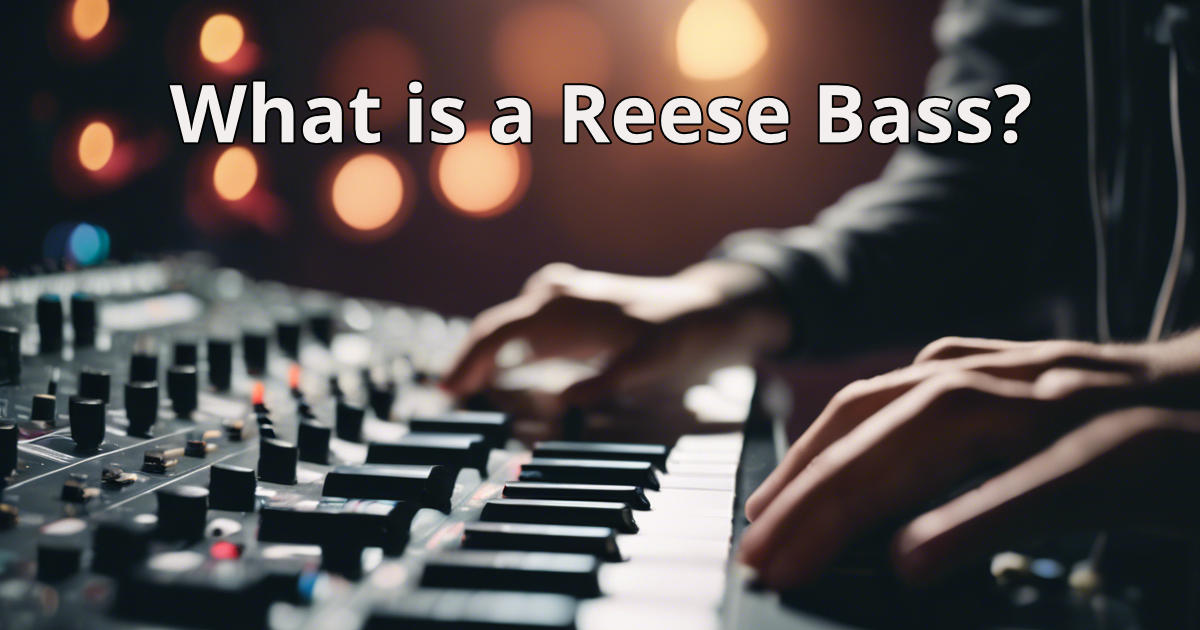Estimated reading time: 7 minutes
Ever been in a club, feeling the music pulse through the air, and suddenly, a deep, growling bass shakes the room? That, my friends, is a Reese bass. It’s not just any bass sound; it’s a rich, complex beast that has dominated dance floors and tracks for decades. Originating from the realms of electronic music, the Reese bass is known for its thick, detuned texture that can vary from smooth to aggressively distorted, making it a favorite among producers and listeners alike.
Table of contents
- History of Reese Bass: Kevin Saunderson and Ray Keith
- The iconic sound of Reese Bass in Dance Music Subgenres
- Deep Dive into Reese Bass: Low-pass Filter, Phase Distortion Synth, and Detuned Oscillators
- Reese Bass’s Breakout Moment: The Jungle Classic
- Exploring the Aggressive Variants of Reese Bass
- Reese Bass and the Casio CZ-5000
- From Basic Sound to Complex Sounds: The Evolution of Reese Bass
- The Role of the Original Sound in Electronic Music Production
- Subtractive Synth vs. Wavetable Synth: Which is best for Reese Bass?
- Understanding the Bass Movement in Reese Bass
- How to Make a Reese Bass: A Step-by-Step Guide
- Conclusion
- FAQs
History of Reese Bass: Kevin Saunderson and Ray Keith
The story of the Reese bass starts in the 80s, with a genius producer named Kevin Saunderson. In Detroit, Saunderson created a track that would become the cornerstone of the Reese bass phenomenon. Then, Ray Keith, another legendary figure, took this sound and spun it into the fabric of early jungle and drum & bass, cementing its place in dance music history. Their pioneering work showed the world the power of this unique sound, setting the stage for countless musical innovations.
The iconic sound of Reese Bass in Dance Music Subgenres
From techno to drum & bass, the Reese bass became a staple, defining the energy and vibe of many tracks. Its versatility is unmatched, able to adapt and fit into various dance music subgenres while still maintaining its distinct character. This iconic sound has been a game-changer, influencing not just producers but the evolution of the genres themselves.

Deep Dive into Reese Bass: Low-pass Filter, Phase Distortion Synth, and Detuned Oscillators
At its core, the Reese bass is a technical marvel. Producers craft this iconic sound using detuned oscillators to create its rich texture. Then, by adding a low-pass filter with just the right filter cutoff, the sound gets its warmth. Phase distortion synths also play a role, adding to the complexity and depth of the bass. Together, these elements create the unmistakable growl of the Reese bass.
| Component | Description |
|---|---|
| Detuned Oscillators | Two or more oscillators slightly detuned from each other to create rich, phasing harmonic interactions. |
| Low-pass Filter | Used to shape the frequency content by attenuating higher frequencies, resulting in a warm and smooth tone. |
| Phase Distortion Synth | Provides complex and evolving timbres by modulating the phase of the waveform, adding depth and character. |
Reese Bass’s Breakout Moment: The Jungle Classic
The moment the Reese bass truly broke out was with its incorporation into jungle music. A jungle classic track featured this bass, and suddenly, everyone wanted that sound. It was raw, it was powerful, and it perfectly complemented the fast-paced breaks of jungle, marking a pivotal moment in dance music.
Exploring the Aggressive Variants of Reese Bass
While the Reese bass started with a fairly smooth texture, producers soon began experimenting, creating more aggressive variants. These heavier versions pushed the boundaries of what the Reese bass could be, adding an edge to tracks that was previously unheard of. This evolution showcased the versatility and potential of the Reese bass to continually reinvent itself.

Reese Bass and the Casio CZ-5000
An interesting twist in the Reese bass saga is its connection to the Casio CZ-5000, a synthesizer known for its phase distortion capability. This synth became a favored tool for crafting the unique sound of the Reese bass, providing the means to explore its sonic possibilities further.
From Basic Sound to Complex Sounds: The Evolution of Reese Bass
The journey of the Reese bass from a basic sound to the complex, layered texture we know today is a testament to the creativity of producers. They’ve taken the foundational elements and pushed them, experimenting with modulation, effects, and synthesis techniques to continually evolve the sound.
| Evolution Stage | Description |
|---|---|
| Basic Sound | Originates from detuned oscillators with a low-pass filter, creating a foundational thick texture. |
| Layered Textures | Producers start layering multiple oscillators and applying modulation for richer, evolving tones. |
| Effects and Processing | Introduction of distortion, chorus, and other effects to add depth, character, and uniqueness. |
| Advanced Modulation | Experimentation with advanced modulation techniques to achieve intricate movement and dynamics. |
| Sonic Exploration | Constant exploration of synthesis methods, effects chains, and sound design for new sonic frontiers. |
The Role of the Original Sound in Electronic Music Production
The original sound of the Reese bass has never lost its charm or relevance in electronic music production. It serves as both inspiration and a foundation, a starting point for new explorations in sound. Its enduring appeal lies in its ability to convey emotion and energy, making it a timeless element in music.
Subtractive Synth vs. Wavetable Synth: Which is best for Reese Bass?
When it comes to creating a Reese bass, the debate between subtractive and wavetable synths is ongoing. Each has its advantages, with subtractive synths offering a classic approach and wavetable synths providing more flexibility in waveform manipulation. Ultimately, the choice depends on the producer’s preference and the specific sound they’re aiming to achieve.
| Synth Type | Subtractive Synth | Wavetable Synth |
|---|---|---|
| Definition | Uses oscillators and filters to subtract harmonics | Utilizes pre-recorded waveforms to generate sound |
| Oscillator Control | Offers precise control over oscillator parameters | Limited control over individual waveform parameters |
| Filter Options | Rich selection of filters for shaping the sound | Often includes basic filter options |
| Detuning Ability | Excellent for detuning oscillators to create thick textures | Detuning capabilities may be limited depending on the synth |
| Modulation | Supports extensive modulation options | May have fewer modulation options than subtractive synths |
| Flexibility | Highly flexible in sound shaping | Generally more straightforward in sound design |
| Customization | Allows deep customization of sound through routing and modulation | Limited customization compared to subtractive synths |
Understanding the Bass Movement in Reese Bass
The movement in a Reese bass line is what gives it life. It’s not just about the notes played but how they’re manipulated over time. Modulating the filter cutoff, adjusting resonance, and playing with LFO rates all contribute to the dynamic, living texture of the Reese bass.
| Bass Movement Aspect | Description |
|---|---|
| Note Progression | Movement of bass notes over time, often following a rhythmic or melodic pattern. |
| Filter Modulation | Dynamic adjustments to filter cutoff frequency, influencing the tone and timbre. |
| Resonance Control | Manipulation of resonance settings for emphasizing certain frequencies in the bass. |
| LFO Rate Adjustment | Modulating parameters like LFO rate to introduce rhythmic fluctuations in the bass. |
| Envelope Tweaking | Fine-tuning envelope settings (e.g., attack, decay) to shape the bass’s transient. |
How to Make a Reese Bass: A Step-by-Step Guide
Creating a Reese bass might seem daunting, but it’s all about understanding the basics and experimenting. Start with two oscillators, detune them slightly, add a low-pass filter, and then tweak from there. Play with distortion, chorus, and phaser effects to add character. Remember, the beauty of the Reese bass lies in its flexibility and the infinite variations you can create.
Conclusion
The Reese bass is more than just a sound; it’s a legacy in electronic music. From its roots with Kevin Saunderson to its role in defining entire subgenres, the Reese bass has proven its staying power and influence. Whether you’re a producer looking to master this sound or a listener simply enjoying the depth it adds to tracks, the Reese bass remains an enduring mystery, continually unraveling with each new track it graces.
Remember, the journey into the world of Reese bass is endless and ever-evolving. Don’t be afraid to experiment and make the sound your own. Happy producing!
Related Posts
- The Reese Bass: A Cornerstone of Electronic Music Production
- What is a MIDI File? Unraveling the Mystery
- What is a VST and How Does it Work? Understanding the Basics
- What is Treble in Music? Breaking it Down
- What is Reverb in Singing and Why it Matters? Decoding the Magic
- What is Plate Reverb? The Simple Guide You’ve Been Waiting For
FAQs
Yes! While hardware synths offer a tactile experience, software synths can also produce a fantastic Reese bass. It’s all about using the right techniques.
Not at all! While it’s a staple in drum & bass, the Reese bass has found its way into techno, dubstep, and beyond.
Detuning is crucial. It’s what gives the Reese bass its thick, rich texture by creating slight phase differences between the oscillators.
Absolutely! With some basic knowledge of synthesis and a bit of experimentation, anyone can start creating their versions of this iconic sound.
There are countless tutorials online, both free and paid, that dive deep into creating Reese bass sounds. Start with YouTube and music production forums for a wealth of knowledge.
